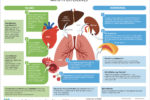The importance of lowering total and LDL cholesterol (LDL-C) in the prevention of cardiovascular disease (CVD) is so firmly established that it has,in only a short time, become part of everyday practice for all primary care health professionals.Lipids,of course,come in multiple forms,which include fatty acids,the different forms of cholesterol and triglycerides.Most practitioners have only a sketchy idea of what triglycerides are,what they do and how important they are.Few understand the intricacies of measurement, diagnosis and interpretation,and when – and how – to manage them.The story is complex and involves difficult biochemical and metabolic concepts,so we should begin at the beginning.























